
Real estate investors can famously defer capital gains taxes on investment properties with a 1031 exchange. They sell a property for a profit then roll the proceeds into a new real estate investment to avoid paying capital gains on the sold property — at least for the moment.
But did you know that you can do a 1031 exchange in reverse?
Keep the following rules and timelines in mind as you explore doing a reverse 1031 exchange.
What Is a Reverse 1031 Exchange?
In a traditional 1031 exchange — also known as a delayed 1031 exchange — you first sell an investment property. You then buy a like-kind property with the proceeds within 180 days of selling the prior property.
This lets you roll over those proceeds into the replacement property without paying capital gains taxes or depreciation recapture on the swapped investment properties. But you’ll still owe both on the new property when you go to sell it.
Unless you 1031 exchange that property into a new one, of course.
“Yeah, yeah, I know how a normal 1031 exchange works. What about reverse 1031 exchanges?”
In a reverse 1031 exchange, you buy the replacement property before selling the current property. For a little while, you own both properties.
That means you need enough money to buy the new property without having sold the relinquished property yet. And since the IRS makes the rules for 1031 reverse exchanges, you can expect all kinds of nitpicking and complications.
Why Do a 1031 Reverse Exchange?
As a real estate investor, you don’t always know when the next deal will come along. You can’t just order a rental property online whenever you feel like it, after all. (Actually, you can on Roofstock, but that’s another story.)
The point is, sometimes great deals on real estate come along when we least expect them. In a competitive market, it’s often hard to find good deals. So the tax code lets you buy the new replacement property before you sell the old property, if that’s more convenient for you.
It also removes the deadline for settling on the new property. If delays strike while purchasing the new property, it simply pushes back your deadline for selling the relinquished property.
You have the flexibility to buy and sell the two respective properties at your own speed, at least within the 180-day window allowed you.
Reverse 1031 Exchange Timeline
In a classic 1031 exchange, you have 45 days after selling the old property to declare the new one. The IRS does let you name three possible properties, since sales contracts can and do fall through.
You have 180 days from the old property’s settlement date to close on the new replacement property to remain in compliance.
The same timeline applies to reverse 1031 exchanges, except backward. Within 45 days of buying the new property, you have to declare which property you’re selling. And you have to settle the sale within 180 calendar days of closing on your new property.
Steps of a 1031 Reverse Exchange
While the concept and timelines are simple, the reverse 1031 exchange process and steps get a little trickier.
These steps include:
-
- Identify the replacement property, and have the funds available to buy it.
- Hire a qualified intermediary (QI) and create an Exchange Accommodation Titleholder (EAT). You and your QI — also known as an exchange facilitator — sign an exchange agreement and they open a limited liability company (LLC) for the sole purpose of temporarily holding the title to your new property until you sell the old one. That LLC serves as the EAT (sick of acronyms yet?).
- Close on the new property.
- Declare the property you’ll relinquish within 45 days of closing on the new property.
- Sign a contract of sale with the buyer of the relinquished property. The seller must be the EAT, not you or your legal entity that holds the deed.
- Legally authorize your QI to transfer the deed of the old property to the buyer. Also outline the transfer of the new replacement property from the EAT to you.
- Sell the relinquished property within 180 days. “Sell” means settle, not sign a contract of sale. The proceeds from the property sale go directly to the QI, who uses them to buy the replacement property from the EAT.
- The QI transfers the replacement property to you. You don’t need to do a separate settlement with the title company for this, it can happen at the same closing or you can just record the transferred deed.
Exchange First vs. Exchange Last
Adding to the complications is the choice between an “exchange first” reverse 1031 exchange or structuring it “exchange last.”
In an exchange first reverse 1031 exchange, you sell the old property to the Exchange Accommodation Titleholder (EAT) for its estimated full-market value as the first step. You provide the money for them to buy it. They then take title to the new replacement property — which you also have to cover financially. Once you find a buyer for the relinquished property and it settles, the EAT reimburses you and the sale proceeds.
In an exchange last deal, you provide the EAT with funds to buy the new property, and they buy it on your behalf. The technical 1031 exchange happens later when they sell the relinquished property.
Whew! Got all that?
The 1031 reverse exchange process involves a lot of middle-men and moving parts. They’re not convenient, nor are they cheap.
And as we alluded to earlier, they come with far too many rules in fine print.
Reverse 1031 Exchange Rules
The first rule of 1031 exchanges: you can’t touch the proceeds from the sold property. That’s why you hassle with a QI and a qualified exchange accommodation arrangement.
In the case of reverse 1031 exchanges, you also can’t own or possess the new replacement property until you sell the old relinquished property. You can’t legally own both properties at the same time.
You can make improvements to the new property once the EAT owns it, however.
As with traditional 1031 exchanges, you can only swap like-kind properties. You also can’t 1031 exchange your primary residence.
The other safe harbor rules apply to both types of exchanges as well. You must own the real property for at least two years, you must have rented it at fair market value for at least 14 days in each year, and you can’t have used the property yourself for more than 14 days in each year (or 10% of the days you rented it to others).
Lastly, if the new property costs less than the relinquished property, you owe taxes on the difference.
(article continues below)
Cost of a 1031 Reverse Exchange
Because intermediary entities have to take title to your properties, it adds considerable cost.
Expect reverse 1031 exchanges to cost between $4,500 – $7,500, not including transfer taxes. That’s significantly more than forward 1031 exchanges.
Speaking of transfer taxes, some states waive them for transfers between you and your EAT, but others don’t. Talk to your QI about the rules in your state.
Challenges of a Reverse 1031 Exchange
By now, you should already have a sense for all the legal gymnastics required for a reverse 1031 exchange.
Chief among the challenges are the costs, of course. But the hurdles don’t end there.
In a reverse 1031 exchange, you have to come up with the money to buy a new property before selling the old property. That means you need to cough up huge quantities of cash out of pocket to cover the exchange funds.
And while you can borrow a rental property mortgage to buy the new property, don’t expect it to be easy. Remember, the EAT will take title to the property initially, not you. That makes most lenders nervous at best. Many simply won’t work with reverse 1031 exchanges.
In an exchange first deal, you can buy the property in your own name in order to appease the lender, with an immediate transfer to the EAT. But lenders also expect you to put in every penny that you earned from selling the old property — an amount you won’t know, since you haven’t sold it yet. That means coughing up even more cash when you close on the new property.
Then there’s the time crunch to sell the original property. Remember, you have 180 days to close on selling the old property. If the property fails to sell, you might have to cut the price below what you planned on getting for it.
Also, beware of contractor delays if your old property needs repairs before selling. Blown repair schedules leave you with even less time to market and sell the property.
Final Thoughts
If you don’t want a steep bill on your next tax return, 1031 exchanges offer a great tax deferment strategy.
You get to swap out a smaller property for a bigger investment opportunity that cash flows better. You skip the payment of capital gains taxes or depreciation recapture for now. And 1031 reverse exchanges add flexibility, letting you find a deal and do the replacement property closing before having to sell the original property. In a seller’s real estate market where it’s hard to find deals, that makes your life easier.
But these tax-friendly real estate transactions come at a cost. You have to pay a princely sum to a qualified intermediary to handle all the paperwork and temporarily hold the replacement property title. It’s a complex transaction, and you typically need to come up with the money for the new property before selling the old one.
When in doubt, talk to an accountant or investment advisor before committing to a reverse 1031 exchange.♦
Still have questions about reverse 1031 exchange timelines? Don’t be shy; ask below!
More Real Estate Investing Reads:
About the Author

G. Brian Davis is a landlord, real estate investor, and co-founder of SparkRental. His mission: to help 5,000 people reach financial independence by replacing their 9-5 jobs with rental income. If you want to be one of them, join Brian, Deni, and guest Scott Hoefler for a free masterclass on how Scott ditched his day job in under five years.



























I should’ve reverse 1031 exchange when I bought out a good deal and sell my old property. The timeline was just right.
Next time Jovan!
Reserve 1031 exchange is pretty handy in certain sitation but quite tricky to pull off since a lot of cash is required.
No question Theodore. Definitely not for all investors or transactions!
Didn’t know you could do 1031 exchanges backwards like this. Another option on the table I suppose
The more tools you have in your real estate investing toolbox, the better!
Seems expensive. Your capital gains tax bill would have to be enormous to make this worthwhile. Thoughts?
I agree, 1031 reverse exchanges make the most sense for high-value properties. Otherwise the juice probably isn’t worth the squeeze.
Could come in handy someday. Thanks for the share
You got it Alfonse!
I never use reverse 1031 exchange in any of my deals but I’ll remember this in case I have a strict time sensitive deals.
I hear you Marie. Always good to have another tool in the toolkit!
What a unique way to protect against tax liability!
Always good to have more options on the table 🙂